
The Asiloidea comprise a very large superfamily insects in the order Diptera, the true flies. It has a cosmopolitan distribution, occurring worldwide. It includes the family Bombyliidae, the bee flies, which are parasitoids, and the Asilidae, the robber flies, which are predators of other insects.

The Asilidae are the robber fly family, also called assassin flies. They are powerfully built, bristly flies with a short, stout proboscis enclosing the sharp, sucking hypopharynx. The name "robber flies" reflects their expert predatory habits; they feed mainly or exclusively on other insects and, as a rule, they wait in ambush and catch their prey in flight.

Dasypogoninae is a subfamily of robber flies in the family Asilidae. There are more than 60 genera and 520 described species in Dasypogoninae.
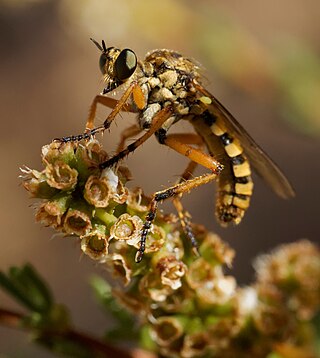
Stenopogoninae is a subfamily of robber flies in the family Asilidae. There are more than 70 genera and 740 described species in Stenopogoninae.

Apachekolos is a genus of robber flies in the family Asilidae, described by Martin in 1957; the genus name was explicitly designated as feminine in gender.

Leptogastrinae is a subfamily of robber flies in the family Asilidae. There are more than 450 described species in Leptogastrinae.
Metadioctria is a genus of robber flies in the family Asilidae. There are at least three described species in Metadioctria.
Cerotainiops abdominalis is a species of robber flies in the family Asilidae.
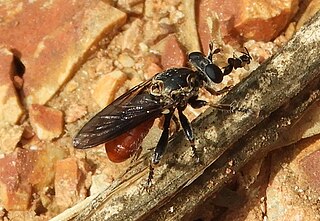
Cerotainiops is a genus of robber flies in the family Asilidae. There are about six described species in the genus Cerotainiops.
Efferia tuberculata is a species of robber flies in the family Asilidae.
Diogmites missouriensis is a species of robber flies in the family Asilidae.
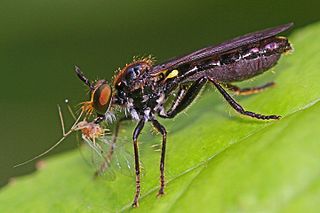
Eudioctria is a genus of robber flies in the family Asilidae. There are about 14 described species in Eudioctria.
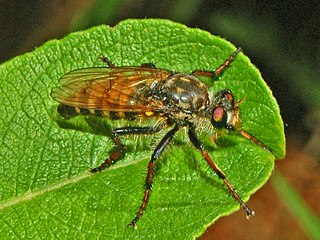
Cyrtopogon is a genus of robber flies in the family Asilidae. There are at least 120 described species in Cyrtopogon.
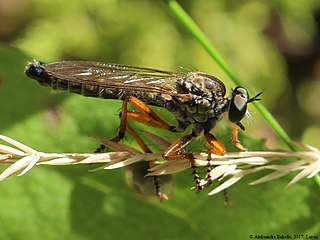
Neomochtherus pallipes, the Devon red-legged robber fly, is a species of robber fly in the family Asilidae.

Neomochtherus is a genus of robber flies in the family Asilidae. There are at least 140 described species in Neomochtherus.

Stichopogoninae is a subfamily of robber flies in the family Asilidae. There are about 14 genera and at least 230 described species in Stichopogoninae.
Odus is a genus of robber flies in the family Asilidae. There is at least one described species in Odus, O. fragilis.
Omninablautus is a genus of robber flies in the family Asilidae.
Diogmites texanus is a species of robber flies in the family Asilidae.

Hyperechia is a genus of robber flies in the family Asilidae. They appear large, stout and with legs covered in bristles and appear like carpenter bees in the genus Xylocopa and the resemblance is considered as a case of aggressive mimicry, providing protection from predators. The larvae of the fly feed on the larvae of Xylocopa within their cavity nests in wood. They are mainly found in the African and Madagascan region with about 15 species and two species in Asia.











